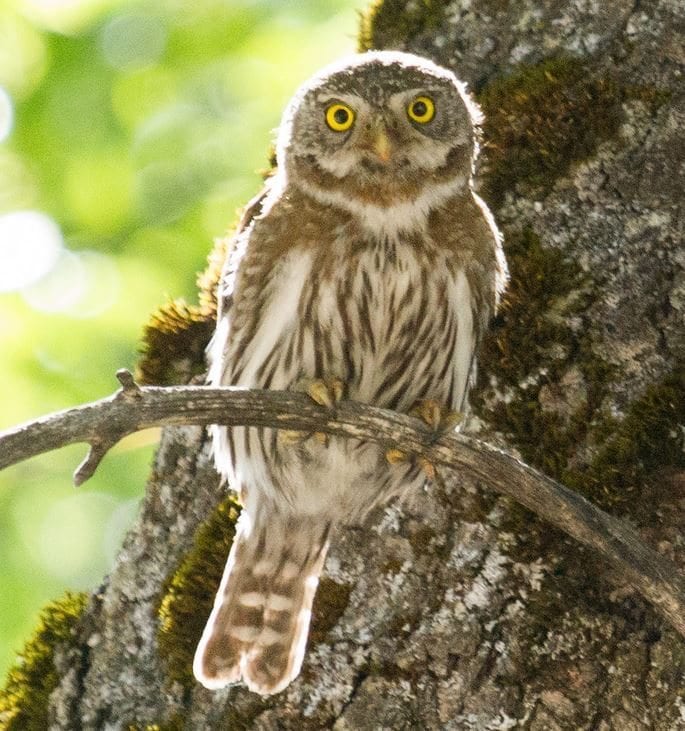My first GGBA Yosemite trip
By Maureen Lahiff
It’s taken me quite a while to combine my love of Yosemite and my love of birds. I get to Yosemite several times a year for day hiking, High Sierra Camp stays, and snowshoeing. I’ve always enjoyed the birds that are easy to see, and I’ve had several fortunate encounters with not-so-easy-to-see-birds – a Sooty Grouse with chicks in the open forest high on the flanks of Half Dome, a Mountain Quail performing a broken-wing injury-feigning display on a trail deep in the Hetch Hetchy backcountry. But only recently have I walked in Yosemite specifically to hear and see birds.
The Golden Gate Bird Alliance trip led by Dave Quady and Dave Cornman the weekend after Memorial Day was an amazing experience. Both leaders, who clearly have long-term experience birding in Yosemite, did a great job scouting and locating active nests a few days before our trip started. They filled us in on the changes in the parts of the Park affected by last summer’s Rim Fire, especially around Hodgdon Meadow. I’m truly grateful for leaders like these two Daves, who know and love Yosemite’s habitats and birds.


With some patience and a lot of help from our fellow birders, we all got a good look at a Warbling Vireo working on a well-concealed nest. I knew Mountain Chickadees were cavity nesters, but I didn’t know that they would nest in a stump! We got close looks at them flying in and out making food deliveries to a tiny hole in the center of a stump no more than two feet high. We saw a juvenile Pileated Woodpecker looking out of its nest hole. A majestic oak harbored both a male Bullock’s Oriole and a male Western Tanager, in full breeding plumage and in perfect sunlight.
We were all looking forward to the possibility of seeing a Yosemite Great Gray Owl. Great Gray Owls, North America’s largest owl by size, range across boreal forests in Alaska, Canada, and the Pacific Northwest. The Great Gray Owls in the Sierra are geographically separated from other Great Gray Owl populations. There are only about 200 of these birds in California; they are listed as a California Endangered Species.
Yosemite National Park is the center of this population. Dave Quady gave us an account of his experiences finding them in the Park, from being almost a certainty in the right habitat in the 1980s to today’s rare experience to be savored. A bit before sunset, we split into two groups and walked slowly at a meadow’s edge.
My group’s first brief sighting of a Great Gray Owl was a classic demonstration of Jon Young’s main point in What the Robin Knows. Dave Quady walked on ahead of us to see why robins were persistently fussing. Before any of us spotted it, Dave got fairly close to the owl, which was perched on a slender branch no more than 20 feet above the ground.

Just as some of us glimpsed it, the owl pooped and took off back into the tree cover. We then sat quietly on a downed log to watch and wait. This owl did not return; however, Dave spotted another owl at the far edge of our meadow, radioed Dave Cornman’s group to join us, and eventually we all got a look through Dave Quady’s scope. For me, and for many of us, it was a memorable life bird.
Great Gray Owls fly low. Auto collisions are a major source of Great Gray Owl deaths in Yosemite; over a dozen deaths have been documented in the last ten years. Because in California they nest mainly in broken-top dead firs and hunt for voles and other small mammals in near-by meadows, their breeding success is affected by logging practices in the National Forests and on private land. Great Gray Owls may not nest every year, even if prey is abundant. They need our help and our voices.
When John Muir spent his first summer in the Yosemite High Country in 1869, Yosemite Valley and the Mariposa Grove of Giant Sequoias were protected, thanks to the June 30, 1864 Yosemite Grant, but the High Country was not. Its meadows were heavily grazed by cattle and its streams were polluted. As Muir recounts in My First Summer in the Sierra, he spent summer 1869 shepherding one such flock of what he came to call “hooved locusts.”
That first summer in the Sierra led to Muir’s life-long commitment to saving Yosemite and many other places. My Yosemite experiences, especially this birding trip, renew my commitment to preserving Yosemite, and its habitats and birdlife, for the next 150 years and beyond.
———————————
Golden Gate Bird Alliance Society offers over 100 field trips each year, mostly in the Bay Area but some further away like Yosemite. GGBA’s next field trip to Yosemite National Park will be May 29-31, 2015. Sign-ups will begin in November 2014; watch the GGBA website for further information.
Maureen Lahiff plans to continue day-hiking in Yosemite to see waterfalls and vistas, to visit the High Sierra Camps when she’s fortunate enough to get a reservation, to snowshoe from Badger Pass to Dewey Point every winter that the snow permits, to add to her informal collection of 100 views of Half Dome, and to see the stars, the Milky Way and the Perseid Meteor Shower on clear Sierra nights. Now she also plans to do more birding in the park.
